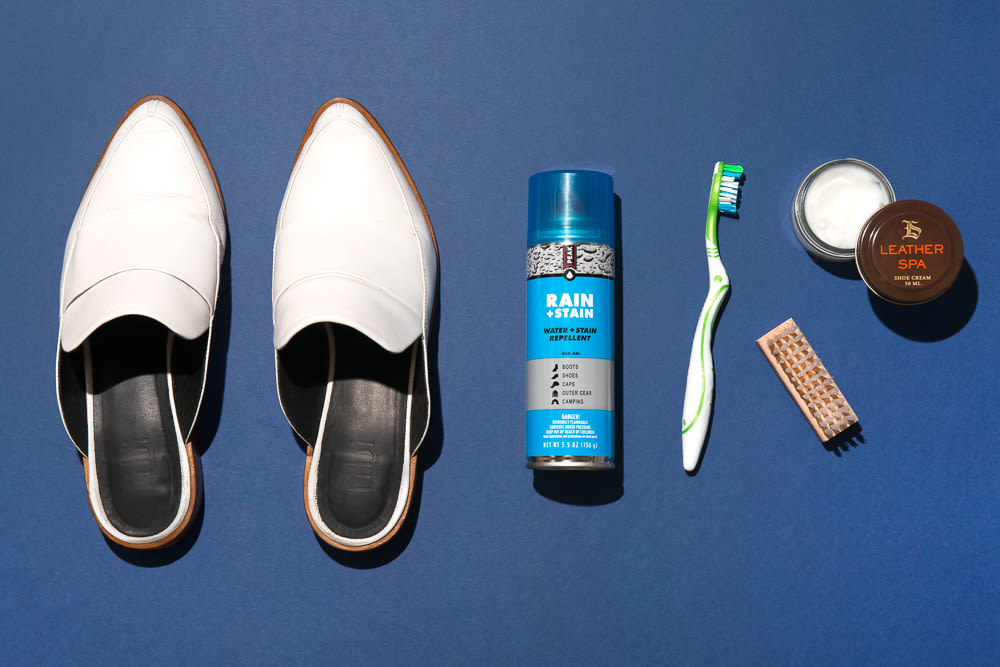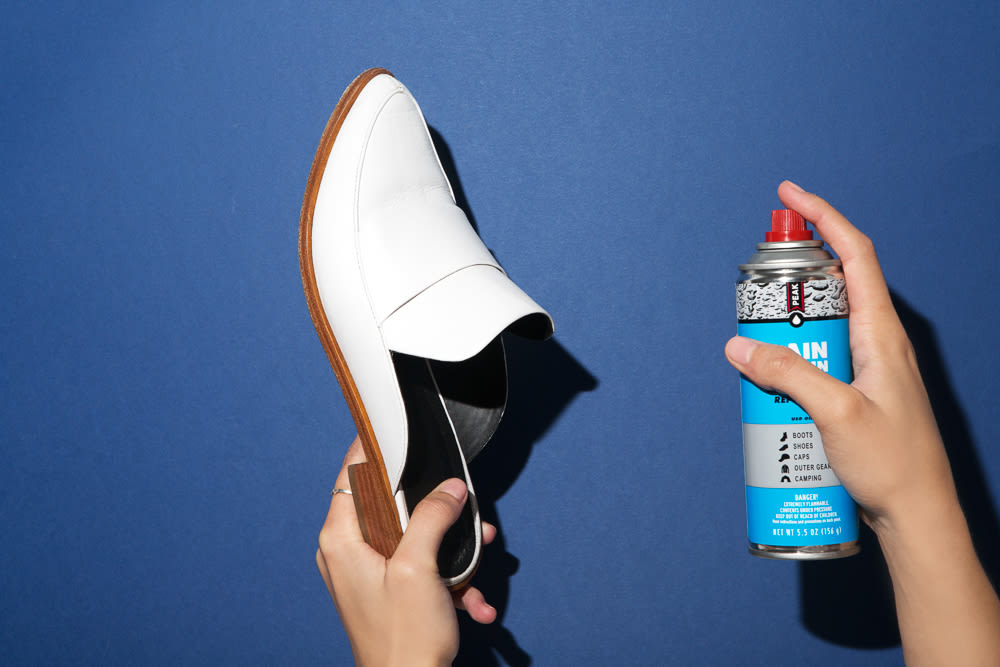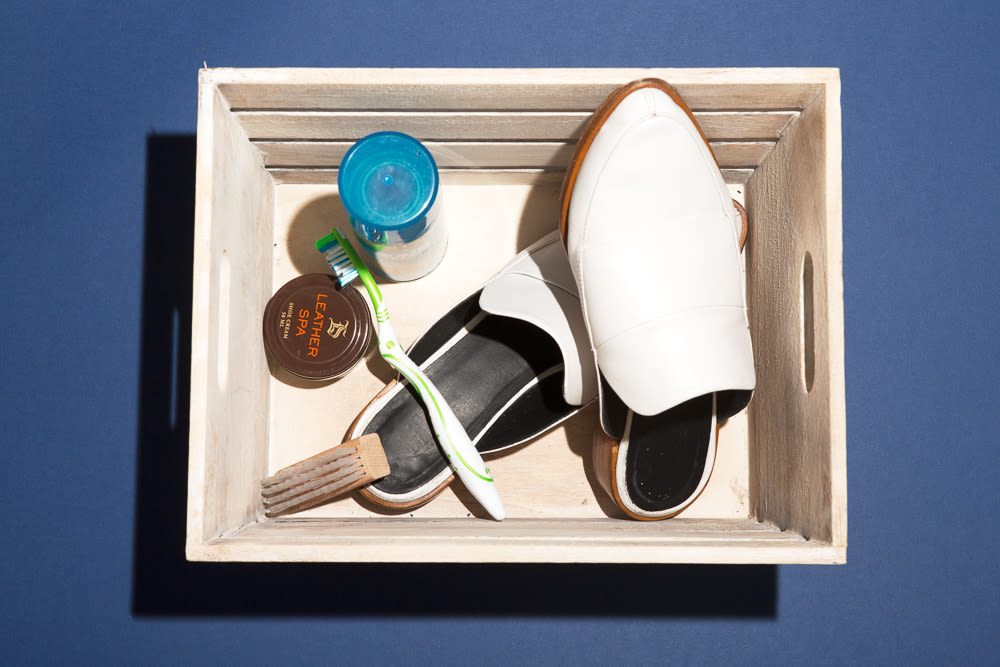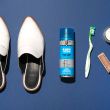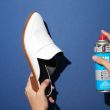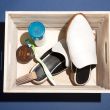When it comes to footwear, quantity can certainly take the backseat to quality—because how many pairs of black ankle boots (or white mules, for that matter) do you really need? Since maintaining quality requires upkeep and care, David Mesquita, VP of New York’s Leather Spa, talked us through the key points to keep in mind while cleaning your leather at home. Break out that waterproofing spray, and take it from a guy who knows, because David’s dealt with everything from shortening heels up to half an inch to restoring pumps that have been Crazy Glue’d. Here’s hoping that we never take it that far.
**Conditioner isn't just for your hair
All leather footwear should be misted with water-repelling spray before use, and last season’s shoes should be conditioned (but not suede—we'll get to that). **The spray won’t make goods waterproof, but “it makes them more water and stain repellent, so in the event that something were to spill, you can wipe it off before it penetrates the leather.” Hold the spray can eight inches away, the same way you would apply hairspray. “If you hold hairspray an inch from your head, you’re going to have that one sticky spot, so you can imagine it would be the same idea with the leather protective spray.” Brush out shoes immediately after applying product, but also later that day, before putting them away at night. “The oils are still in the skin so if you have a horsehair brush, you can brush the shoes to bring back that sheen, bring back the oils, and also remove any dust or dirt that has probably accumulated throughout the day.”
**Apply early and often
**Sprays and conditioning creams should be reapplied every two-three weeks. The only product that’s possible to overdo it with is wax, which is a paste used for achieving a high shine. “Too much wax over time is bad for the leather because it’s going to start sealing in the pores and the leather won’t be as breathable.”
**Suede requires its own products
**When suede loses its color due to winter weather, David recommends Suede Renew, a spray that deposits color, in navy, black, or brown, back on to the shoe. For everyday cleaning, use a suede brush with firm bristles, or a suede eraser with a slightly rough surface that helps scrub the dirt from the fibers. David advises using the eraser and brushing afterwards in various directions to get the most impact.
**Spot clean with care
**With slush and snow, salt accumulates on shoes, leaving annoying marks and water lines. To rid your boots of these markings is actually pretty simple—dilute one part vinegar with two parts water (straight vinegar will leave a strong after scent) and rub the solution into the shoe using a towel. This process strips the material of its natural oils, so reapply your protecting spray and conditioner after the process. For troubled marks, a problem on white shoes in particular, use a cream cleanser, like Leather Spa's Perfect Gel, or mix a soft soap with some water and apply it with a soft brush or sponge. A less DIY option: buy a pre-mixed leather shampoo. For tough stains, use a very soft toothbrush “that’ll help break up the dirt to make it catch on the leather.”
**Shoe deodorant is a thing, and you should use it
**Look for a spray that will kill bacteria (like Gehwol Caring Footdeo). In shoes with an inner sole, like sneakers, remove it and spray beneath the sole, too.
**Replace the heel caps on vintage shoes
**After a few years, most heel caps deteriorate. David explains that the decay isn’t visible on most shoes, but when you take a step the heel can fall apart. This shouldn’t discourage anyone from shopping vintage because this is a simple repair that ranges from $12-$20, depending on the cobbler. The overall health of shoes can be determined by simply touching the leather—you should be able to flex it, and it shouldn’t feel stiff to the touch.
**When the season’s over, store them properly
**While David recommends storing shoes in their original boxes, that’s probably not possible unless you have something of a dream-level walk-in closet. His suggested alternative, shoe trees, help footwear keep their original shape. Cedar shoe trees are top o’ the line but are between $20-$30 per pair. Plastic shoe trees will get the job done at around $5 per pair. Finally, if they’re really dirty at the end of the season, have them cleaned “because by the next season when you take them out, those stains are going to be embedded into the leather, and it could be very hard or impossible to get them out.”
Photographed by Tom Newton.
